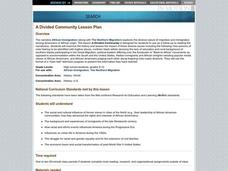Curated OER
A Divided Community
Students work in teams to research the history of African migration and immigration in the U.S. They present their research in a town hall discussion format and then write a paragraph about their experiences.
Curated OER
Education as a Civil Right
Students explore the implications of segregation. For this Civil Rights lesson, students investigate what equal education is as they discover the state of Boston schools in 1960. Students define civil rights and discrimination as they...
Curated OER
Brush Up On Respect
Students define respectful behavior and complete related activities. In this respectful behavior lesson, students use toothpaste to illustrate the cleansing power of speaking good words and having good manners. Students discuss rudeness...
Curated OER
Take a Memo - Primary Documents: African American Soldiers on the Homefront
Pupils examine the discrimination experienced by black servicemen during World War II. They read and analyze an official memo written in 1943, complete worksheet questions, and participate in a class discussion.
Curated OER
Oh My Gosh, It's a Bosch
Students explore the art of Hieronymous Bosch. In this surreal art lesson, students look at paintings by the Dutch painter and then follow the provided steps to create their own surreal piece inspired by his works.
Curated OER
Universal Suffrage
Young scholars explore concept of suffrage. For this voting rights lesson, students participate in a classroom activity that excludes girls from voting. Young scholars discuss gender issues and write essays regarding the restriction of...
Curated OER
Social Activism In The United States
Middle schoolers explore justice issues. In this social activism lesson, students watch "Social Activism in the United States," and then locate newspaper articles from the 1960's and 1970's about events during the era.
Curated OER
Learning about Africville
Students research the history of Africville in Canada and present their findings to the class.
Curated OER
Math: Where Do I Put the Elephant?
Students listen to the story, "Harriet Goes to the Circus," to launch into a lesson plan on positional words, such as over, under, and behind. After clipping out and coloring pictures of circus animals, students place them into a parade...
Curated OER
Copper Tooling
Students examine different examples of Mycenaean masks. They discuss the history of the masks and why they might have been made. They give their opinions and their responses are recorded.
Curated OER
Creating a Collage
Fifth graders identify and describe the characteristics of collages. They familiarize themselves with the history of collage making. They select pictures from magazines that relate to their chosen word of the week. They design a collage.
Curated OER
Using Political Cartoons and Propaganda in Teaching the Holocaust
Students gain an understanding of the Holocaust through analysis of political cartoons. In this Holocaust activity, students examine propaganda in political cartoons that were used in Nazi Germany.
Curated OER
Be a Good Egg
Students use an eggshell decay to represent what happens when a person loses someone's trust. In this trust lesson, students discuss decay and complete an eggshell decay activity. Students use the experiment to represent what happens...
Curated OER
Things That Make Us Want To Scream
Learners create a drawing of Edvard Munch's "The Scream" and draw items that make them want to scream in this creative Art lesson for the Middle or High School classroom. The lesson includes resource links for artwork and background...
Curated OER
Log Cabin
Students create log cabins out of strips of construction paper in this Art activity for the early-elementary classroom. Emphasis is placed on the study of how people live today versus in the distant past. A resource link is included...
Curated OER
The Life Masks of Lincoln
Students analyze two life masks of Abraham Lincoln. For this Life Masks of Lincoln lesson students determine which events during his presidency formed the change in Lincoln's countenance. Lastly students create a timeline of important...
Curated OER
Kandinsky Color Studies
Students study the artist Wassily Kandinsky as well as his art and and music. In this art appreciation lesson, students view a variety of Kandinsky's work and circular color studies. Students relate the use of color to emotion and listen...
Curated OER
Create a Cat with Amaco Scuptamold and Wireform Metal Mesh
Learners create an animal from Sculptamold and metal mesh. In this hands-on arts lesson, students use the materials provided the create a piece of art in the form of an animal. This lesson includes easy step-by-step directions.
Curated OER
Our Unfinished Work
Students investigate the racism elements after the election of President Barack Obama. In this racism lesson, students read a recent article about 'post-racial' society. Students compile a list of achieving a post-racial society and...
Curated OER
Masks
Young scholars create weather masks. In this social studies lesson, students discover the history behind the weather masks used by Native American cultures and then create their own.
Curated OER
U.S. History: The Second Great Migration
Students examine the migration of rural African Americans to northern cities following World War !!. After predicting the effects of cultural and economic factors, they write essays explaining the impact of migration on communities and...
Curated OER
A Common Thread
Sixth graders explore the Renaissance. In this Renaissance activity, 6th graders study the culture and society of the middle ages. Students research the geography and climate of the times and discover how these affected agriculture.
Curated OER
Everybody Cooks Rice
Students read the book, "Everybody Cooks Rice," and they participate in activities pertaining to the book. They identify countries mentioned in the text and locate them on a world map. They use an atlas to identify the climatic...
Curated OER
The Homefront: America and WWII
Students are introduced to the experiences of various groups of Americans at home during WWII, highlighting race, gender, and ethnicity. They improve their ability to analyze and interpret historical documents and images.

























